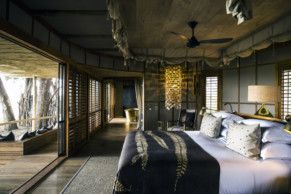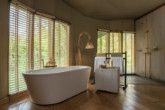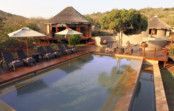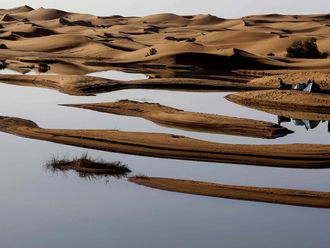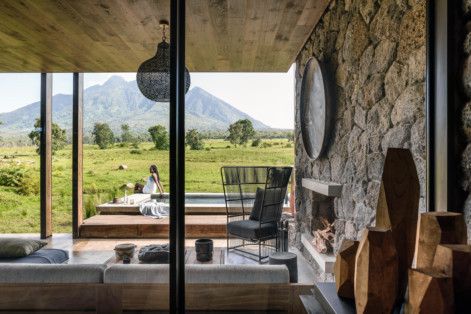
Safari camps are the stuff of dreams and bucket lists. They can also be leaders in conservation, sustainability, design, eco-sensitivity and hospitality.
Take Kisawa Sanctuary, set to open next summer on an island off the coast of Mozambique. The construction of the marine safari camp incorporated 3D sand printing, along with traditional weaving, thatching and textile work. Care was also taken not to disturb the orcas, humpback whales and manta rays in the surrounding waters.
Or consider Natural Selection’s Kwessi Dunes Lodge, due to open next spring in Namibia’s staggeringly vast desert wilderness. Each bedroom will feature a “star gazer” room so guests can take in the night sky.
There’s also Meridian Adventure SAIL, an ocean safari via six fancy catamarans - based in the pristine coral triangle of Raja Ampat, Indonesia - that leaves almost no footprint at all.
As places to glimpse creatures great and small, or as gateways to the back of beyond (where you can seriously get away from it all), safari camps may be the ultimate hotel. Here are five prospects, all outstanding in their field.
Upfront with gorillas in Rwanda
On 178 acres at the edge of Volcanoes National Park in northwestern Rwanda, this new lodge sits close to the habitat of one-third of the world’s remaining mountain gorillas. It opened in August as the 15th in Singita’s collection of conservation-focused and sustainably minded lodges, often used by blue-chip travel outfits such as Red Savannah.
The eight suites (plus a private villa) are done up in worldly African elegance, with indoor and outdoor fireplaces, heated plunge pools, woven ceilings and hand-fired brick work (by local artisans), along with views of the Sabyinyo, Gahinga and Muhabura volcanoes from window seats and deep bathtubs. An unusual amenity: a nursery that so far has provided some 250,000 trees and shrubs as part of the company’s reforestation effort to protect and preserve the silverbacks and their families.
Sounds of the bush in KwaZulu-Natal
This Big Five compound inside a 34,000-acre private game reserve began as the site of the Swedish owner’s family villa. It has grown to include a series of suites surrounding a central lodge and an encampment of 15 tents - rustic but deluxe - secluded in a thicket of wilderness in the South African province of KwaZulu-Natal.
With canvas walls and wooden floors that extend to outdoor decks, the west-facing tents take full advantage of nature - from sunsets to the sounds of the bush. (There are around 400 bird species to take in here.) Gravel pathways lead from the tents to a common, open-air lounge with a high-beamed ceiling that overlooks a sleek swimming pool and fire pit, where guests can trade stories of the day’s sightings. The black rhino and cheetah can be elusive, but there are spindly giraffes and young zebra dotting the landscape, and herds of elephants trundle along to the watering hole at cocktail hour.
Mombo in Botswana: preserving nature at every turn
Built in 1990, Wilderness Safaris’ flagship - at the northern end of Chief’s Island in the Moremi Game Reserve, in Botswana’s Okavango Delta - has recently unveiled a $10 million renovation. The project was to bring the traditional camp up to design and environmental standards without disturbing the natural habitat. (An arborist, for example, was enlisted to oversee the protection of trees and roots.)
Behind the scenes, Mombo is now 100% solar powered, with sophisticated sewage and water filtration systems. More obvious is the English oak, from managed forests in Croatia, used for guest-room floors; Iroko hardwood from West Africa for doors and windows; and plenty of original materials re-purposed here and there (and at the company’s other camps on the continent).
The nine tented suites are big, with a sitting room and bar, separate bathrooms and dressing rooms, indoor and outdoor showers, and sliding louvred shutters that open onto an ample deck, from which to spy the exotic wildlife just out of reach. An eclectic mix of local grasses and fabrics, brass, copper, wooden furniture - Pygmy beds from Congo used as coffee tables - and cracked-leather headboards give the spaces a sense of globe-trotting chic.
Kanha National Park, India
The latest of four lodges set up by Taj in association with the travel company &Beyond, this is a good headquarters for tiger-spotting and bird-watching. It sits alongside the Banjaar River at the foot of Kanha National Park (a reserve that is part of a tiger-protection program), with 18 tented huts arranged in east and west camps, each group with its own bar, dining room and pool.
Inside, there are woven bamboo on the walls and raised bed frames, wrought-iron furnishings, art from the nearby Indian state of Chhattisgarh, a soaking tub in the bright bathrooms, and sliding glass doors that open onto decks at the water’s edge. In the morning, discreet butlers will deliver coffee or tea via small hatches.
Costa Rica: luxury amidst nature
Opened in December, this air-conditioned tent camp changes the luxury game in Costa Rica. It was designed by Luxury Frontiers - the architects noted in Africa for camps such as Zambia’s Puku Ridge and Botswana’s Belmond Savute Elephant Lodge - as its first foray into the Americas. Each fabric-roofed, 750-square-foot villa has canvas walls, suspended floors, a tropical modern interior design (see the mosquito netting on the four poster bed and the botanical mural behind it) and an outdoor deck with a plunge pool filled by local hot springs.
Set in the Arenal Volcano National Park, the camp shares 62 acres with its sister properties, Nayara Gardens and Nayara Springs, all connected by suspended footbridge, or golf cart, if you must. The company has reserved a patch of the resort’s land as a refuge for the sloth (the strange, smiling star of the rainforest) and has begun to plant Guarumo trees to attract and protect them.
The New York Times News Service


